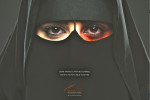Exactly a year ago on March 15th, the official day of Syrian uprising, I wrote about the Vogue feature on Syrian first-lady Asma al-Assad, which glamorized the haute couture-clad co-dictator while painting a painful picture of a woman genuinely fighting, on her own terms, for “democracy” in Syria. The piece itself could not have been scheduled for a more opportune time: the so-called Arab world was, at the time, experiencing a wave of uprisings challenging old but adamant self-appointed kings who sat on bloodied thrones.

Asma al-Assad with her husband. Image via the Toronto Star.
Both the timing and subject of the piece were, ironically, in extremely bad taste for the premier fashion magazine, coinciding with the “official” start of the democratic uprising in Syria. It seemed as though those involved in the production of the piece were too enamored by the “enigma” that was Asma al-Assad to condemn (or even pay a semblance of acknowledgment to) her marriage to a dictator and her role in a renowned brutal dictatorship. The compelling confusion that Asma induced, as a white European woman clad in the skin and name of a Muslim, rendered all else irrelevant and insignificant.
And despite the bloody turn the so-called “Arab Spring” has taken in the past few months, particularly in Syria, little has seemed to change in the glorifying characterizations afforded to the wives of ruthless dictators. This especially applies to Asma al-Assad, who remains a proverbial crack-laden fixation.
On March 15th of this year, the Toronto Star celebrated the one year anniversary of the Syrian uprising by publishing a piece (uncomfortably) titled “Real Housewives of the Arab Spring: Dictators’ big-spending spouses draw citizens’ ire.” The article, written by the Star’s foreign correspondent Olivia Ward, focuses on the un-ending trope of First Lady Dictator Expenditure and is filled to the brim with fascination and tabloid-worthy obsessive commentary. This is all perhaps unsurprising for a piece that actually dares to begin with:
“Asma’s jewels, Safia’s stash, Leila’s family fortune.
They’re the Baronesses of Bling, the Empresses of Excess.”
The article touches upon Egypt’s Suzanne Mubarak, Tunisia’s Leila Trabelsi and Libya’s Safia Farkash. The real protagonist of the piece, however, remains Syria’s Asma al-Assad. Ward notes that al-Assad stands apart from her counterparts, who are currently facing legal backlash for the roles they played in the perpetuation and sustenance of dictatorship and violation of human rights and international law in their respective countries:
“Suzanne Mubarak, wife of former Egyptian president Hosni, is under a European Union arrest warrant on money laundering charges. And Safia Farkash, second wife of Libyan dictator Moammar Gadhafi, was put on a sanctions blacklist by the U.S. Treasury Department, along with other survivors of his regime.
So far, none of that applies to Asma Assad…”
The piece goes on to discuss, with the help of Joshua Landis, the failure of the “great potentiality” that could have been, Asma al-Assad, who apparently was initially seen as “the best thing that happened to Syria,” being the “beautiful Sunni princess” that she was. The gaga-lovefest continues as Landis points out that if there’s anything we have learned about the first lady through the past year and the extremely questionable leaked emails obtained by the Guardian (through the opposition, which must have proven itself trustworthy), it’s that Asma and Bashar “love each other” and that Asma actually seems to believe, like her husband, “that the opposition are Islamic fundamentalists who are going to destroy the harmony of a secular country where all the sects can get along.”
In addition to what a “rose in the desert” (à la Vogue) Asma al-Assad was and could have been, there remains a fixation on her reported lavish spending during the civil conflict that rages across major cities in Syria, despite the shaky evidence this repeated assertion rests upon. Unsurprisingly, there’s a general focus on the lavish lives lived by first ladies of dictatorships, uneasily following the theme that women “love them riches.” This is a striking break from the relatively recent pieces that heralded these very first ladies as “leading the way” for the women of the “Arab world.” These women have gone from their aristocratic allure and penchant for public service and relations, dealing with “important issues” of women’s rights and empowering the youth, to materialistic, detached, authoritatively appointed queens by virtue of marriages. However their ability to be stylish and charming, as evidenced and influenced by their Western background or inclination, remains untouched by political upheaval.
As much as Asma al-Assad, Suzanne Mubarak, Leila Trabelsi and others are wives and mothers, they are also women in positions of power and privilege afforded to them by the brutal dictatorships of their spouses. While before they were lauded as women who were using their power for “social good” and civic empowerment, they are now being touted as women who used their positions primarily for material gain. But how does this separate them from their husbands, who also enjoyed lavish lifestyles? Is it just because of their womanhood and roles as wives that their materialism deserves specific attention and condemnation? Or is that just the only sexy news we want to hear about famous Louboutin-clad Arab Muslim women?
These women were and are not victims of circumstance. Rather, they are active participants in upholding dictatorship and oppression of the very people they claim to represent. They enthusiastically provided and continue to provide a “feminine” and “empowering,” as well as, in some cases, “Western” face to the international public, attempting to cover the ugliness of the dictatorship.
They are propagandists, not sexy headlines to sell gossip disguised as news.


